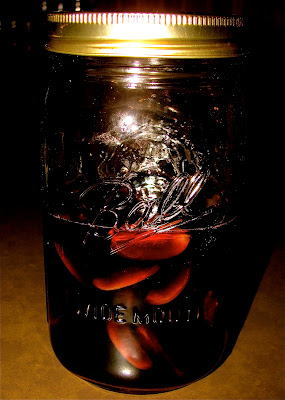It's a beautiful thing, right?
A homemade pizza, baked in a standard gas oven. I don't know about you, but this is the first such specimen I have ever seen that looks quite like this.
And so when Mister Meatball's in-house pizzaioli Tom and Beth spied Lahey's recipe in the March 2012 issue of Bon Appetit, it didn't take long for them to get to work.
Poor me.
The full recipe is below, but here's how it starts: with a dough that rises for around 18 hours.
Lahey's recipe makes a lot of pizza, six of them actually.
And so the batch needs to be carefully divided and handled.
Look at those beautiful bubbles. I've never seen a homemade pizza dough act quite this way before.
What can I say? My head's still spinning.
Tom and Beth insist that they will never again use another recipe. And that's good enough for me.
It's worth trying. Trust me on this one. Please.
Jim Lahey's No-Knead Pizza
Recipe
Makes 6 10" to 12" pizzas
Ingredients
7 1/2 cups all-purpose flour (1000 grams) plus more for shaping dough
4 teaspoons fine sea salt
1/2 teaspoon active dry yeast
Preparation
Whisk flour, salt, and yeast in a medium bowl. While stirring with a wooden spoon, gradually add 3 cups water; stir until well incorporated. Mix dough gently with your hands to bring it together and form into a rough ball. Transfer to a large clean bowl. Cover with plastic wrap and let dough rise at room temperature (about 72°) in a draft-free area until surface is covered with tiny bubbles and dough has more than doubled in size, about 18 hours (time will vary depending on the temperature in the room).
Transfer dough to a floured work surface. Gently shape into a rough rectangle. Divide into 6 equal portions. Working with 1 portion at a time, gather 4 corners to center to create 4 folds. Turn seam side down and mold gently into a ball. Dust dough with flour; set aside on work surface or a floured baking sheet. Repeat with remaining portions.
Let dough rest, covered with plastic wrap or a damp kitchen towel, until soft and pliable, about 1 hour. DO AHEAD: Can be made 3 days ahead. Wrap each dough ball separately in plastic wrap and chill. Unwrap and let rest at room temperature on a lightly floured work surface, covered with plastic wrap, for 2-3 hours before shaping.
To Make the Pizzas
During the last hour of dough's resting, prepare oven: If using a pizza stone, arrange a rack in upper third of oven and place stone on rack; preheat oven to its hottest setting, 500°-550°, for 1 hour. If using a baking sheet, arrange a rack in middle of oven and preheat to its hottest setting, 500°-550°. (You do not need to preheat the baking sheet.)
Working with 1 dough ball at a time, dust dough generously with flour and place on a floured work surface. Gently shape dough into a 10"-12" disk.
If Using Pizza Stone
When ready to bake, increase oven heat to broil. Sprinkle a pizza peel or rimless (or inverted rimmed) baking sheet lightly with flour. Place dough disk on prepared peel and top with desired toppings.
Using small, quick back-and-forth movements, slide pizza from peel onto hot pizza stone. Broil pizza, rotating halfway, until bottom of crust is crisp and top is blistered, 5-7 minutes.
Using peel, transfer to a work surface to slice. Repeat, allowing pizza stone to reheat under broiler for 5 minutes between pizzas.
If Using a Baking Sheet
Arrange dough disk on baking sheet; top with desired toppings. Bake pizza until bottom of crust is crisp and top is blistered, about 10 minutes. Transfer to a work surface to slice. Repeat with remaining pizzas.
























